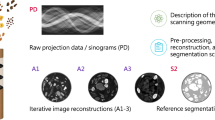Abstract
This paper presents a novel patient repositioning method from limitedangle tomographic projections. It uses a machine learning strategy. Given a single planning CT image (3D) of a patient, one applies patient-specific training. Using the training results, the planning CT image, and the raw image projections collected at the treatment time, our method yields the difference between the patient’s treatmenttime postition and orientation and the planning-time position and orientation. In the training, one simulates credible treatment-time movements for the patient, and by regression it formulates a multiscale model that expresses the relationship giving the patient’s movements as a function of the corresponding changes in the tomographic projections. When the patient’s real-time projection images are acquired at treatment time, their differences from corresponding projections of the planning-time CT followed by applications of the calculated model allows the patient’s movements to be estimated. Using that estimation, the treatment-time 3D image can be estimated by transforming the planning CT image with the estimated movements,and from this, changes in the tomographic projections between those computed from the transformed CT and the real-time projection images can be calculated. The iterative, multiscale application of these steps converges to the repositioning movements. By this means, this method can overcome the deficiencies in limited-angle tomosynthesis and thus assist the clinician performing an image-guided treatment. We demonstrate the method’s success in capturing patients’ rigid motions with subvoxel accuracy with noise-added projection images of head and neck CTs.
Access this chapter
Tax calculation will be finalised at checkout
Purchases are for personal use only
Preview
Unable to display preview. Download preview PDF.
Similar content being viewed by others
References
Maltz, J.S., Sprenger, F., Fuerst, J., Paidi, A., Fadler, F., Bani-Hashemi, A.R.: Fixed gantry tomosynthesis system for radiation therapy image guidance based on a multiple source x-ray tube with carbon nanotube cathodes. Medical Physics 36(5), 1624–1636 (2009)
Andersen, A.H., Kak, A.C.: Simultaneous algebraic reconstruction technique (SART): a superior implementation of the ART algorithm. Ultrasonic Imaging 6(1), 81–94 (1984)
Sadowsky, O., Ramamurthi, K., Ellingsen, L.M., Chintalapani, G., Prince, J.L., Taylor, R.H.: Atlas-assisted tomography: registration of a deformable atlas to compensate for limited-angle cone-beam trajectory. In: 3rd IEEE International Symposium on Biomedical Imaging: Nano to Macro, pp. 1244–1247 (2006)
Thilmann, C., Nill, S., Tucking, T., Hoss, A., Hesse, B., Dietrich, L., Bendl, R., Rhein, B., Haring, P., Thieke, C.: Correction of patient positioning errors based on in-line cone beam CTs: clinical implementation and first experiences. Radiation Oncology 1(1), 16 (2006)
Wu, Q.J., Godfrey, D.J., Wang, Z., Zhang, J., Zhou, S., Yoo, S., Brizel, D.M., Yin, F.F.: On-board patient positioning for head-and-neck IMRT: comparing digital tomosynthesis to kilovoltage radiography and cone-beam computed tomography. International Journal of Radiation Oncology, Biology, Physics 69(2), 598–606 (2007)
Yoo, S., et al.: Clinical evaluation of positioning verification using digital tomosynthesis (DTS) based on bony anatomy and soft tissues for prostate image-guided radiation therapy (IGRT). International Journal of Radiation Oncology, Biology, Physics 73(1), 296 (2009)
Zhang, J., Wu, Q.J., Godfrey, D.J., Fatunase, T., Marks, L.B., Yin, F.F.: Comparing digital tomosynthesis to Cone-Beam CT for position verification in patients undergoing partial breast irradiation. International Journal of Radiation Oncology, Biology, Physics 73(3), 952–957 (2009)
Russakoff, D., Rohlfing, T., Maurer, C.: Fast intensity-based 2D-3D image registration of clinical data using light. In: Proceedings. Ninth IEEE International Conference on Computer Vision, vol. 1, pp. 416–422 (2003)
Cootes, T.F., Edwards, G.J., Taylor, C.J.: Active appearance models. IEEE Transactions on Pattern Analysis and Machine Intelligence 23(6), 681–685 (2001)
Author information
Authors and Affiliations
Editor information
Editors and Affiliations
Rights and permissions
Copyright information
© 2010 Springer-Verlag Berlin Heidelberg
About this paper
Cite this paper
Chou, CR., Frederick, C.B., Chang, S.X., Pizer, S.M. (2010). A Learning-Based Patient Repositioning Method from Limited-Angle Projections. In: Angeles, J., Boulet, B., Clark, J.J., Kövecses, J., Siddiqi, K. (eds) Brain, Body and Machine. Advances in Intelligent and Soft Computing, vol 83. Springer, Berlin, Heidelberg. https://doi.org/10.1007/978-3-642-16259-6_7
Download citation
DOI: https://doi.org/10.1007/978-3-642-16259-6_7
Publisher Name: Springer, Berlin, Heidelberg
Print ISBN: 978-3-642-16258-9
Online ISBN: 978-3-642-16259-6
eBook Packages: EngineeringEngineering (R0)




